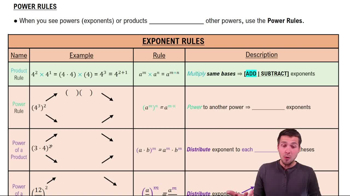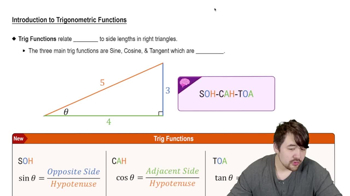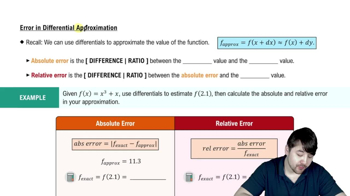Table of contents
- 0. Functions7h 52m
- Introduction to Functions16m
- Piecewise Functions10m
- Properties of Functions9m
- Common Functions1h 8m
- Transformations5m
- Combining Functions27m
- Exponent rules32m
- Exponential Functions28m
- Logarithmic Functions24m
- Properties of Logarithms34m
- Exponential & Logarithmic Equations35m
- Introduction to Trigonometric Functions38m
- Graphs of Trigonometric Functions44m
- Trigonometric Identities47m
- Inverse Trigonometric Functions48m
- 1. Limits and Continuity2h 2m
- 2. Intro to Derivatives1h 33m
- 3. Techniques of Differentiation3h 18m
- 4. Applications of Derivatives2h 38m
- 5. Graphical Applications of Derivatives6h 2m
- 6. Derivatives of Inverse, Exponential, & Logarithmic Functions2h 37m
- 7. Antiderivatives & Indefinite Integrals1h 26m
- 8. Definite Integrals4h 44m
- 9. Graphical Applications of Integrals2h 27m
- 10. Physics Applications of Integrals 2h 22m
4. Applications of Derivatives
Differentials
Problem 4.R.63
Textbook Question
60–81. Limits Evaluate the following limits. Use l’Hôpital’s Rule when needed.
lim_Θ→0 (3 sin² 2Θ) / Θ²
 Verified step by step guidance
Verified step by step guidance1
First, identify the form of the limit as Θ approaches 0. The expression (3 sin² 2Θ) / Θ² is in the indeterminate form 0/0, which suggests that l'Hôpital's Rule can be applied.
Apply l'Hôpital's Rule, which states that if the limit of f(Θ)/g(Θ) as Θ approaches a value results in an indeterminate form, then the limit can be found by taking the derivative of the numerator and the derivative of the denominator separately.
Differentiate the numerator: The derivative of 3 sin² 2Θ with respect to Θ involves using the chain rule. First, differentiate sin² 2Θ to get 2 sin 2Θ * cos 2Θ, and then multiply by the derivative of 2Θ, which is 2. Therefore, the derivative of the numerator is 12 sin 2Θ * cos 2Θ.
Differentiate the denominator: The derivative of Θ² with respect to Θ is straightforward, which is 2Θ.
Now, evaluate the limit of the new expression (12 sin 2Θ * cos 2Θ) / (2Θ) as Θ approaches 0. Simplify the expression and check if further application of l'Hôpital's Rule is needed or if the limit can be directly evaluated.
 Verified video answer for a similar problem:
Verified video answer for a similar problem:This video solution was recommended by our tutors as helpful for the problem above
Video duration:
5mPlay a video:
Was this helpful?
Key Concepts
Here are the essential concepts you must grasp in order to answer the question correctly.
Limits
Limits are fundamental concepts in calculus that describe the behavior of a function as its input approaches a certain value. They help in understanding the function's behavior near points of interest, including points where the function may not be explicitly defined. Evaluating limits is crucial for determining continuity, derivatives, and integrals.
Recommended video:

One-Sided Limits
L'Hôpital's Rule
L'Hôpital's Rule is a method for evaluating limits that result in indeterminate forms, such as 0/0 or ∞/∞. It states that if the limit of f(x)/g(x) leads to an indeterminate form, the limit can be found by taking the derivative of the numerator and the derivative of the denominator separately. This rule simplifies the process of finding limits in complex functions.
Recommended video:
Guided course

Power Rules
Trigonometric Functions
Trigonometric functions, such as sine and cosine, are periodic functions that relate angles to ratios of sides in right triangles. In calculus, they are often involved in limits and derivatives due to their unique properties, such as periodicity and boundedness. Understanding their behavior, especially near critical points like 0, is essential for evaluating limits involving trigonometric expressions.
Recommended video:

Introduction to Trigonometric Functions







